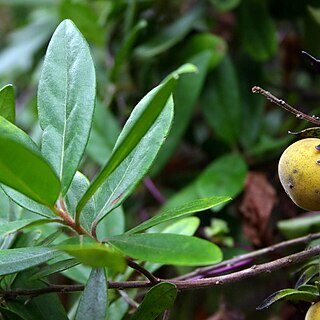A shrub 2-3 m in height, or a small to medium-sized, densely leafy tree with ascending branches, up to 13 m. Bark: grey to brown, rather smooth or wrinkled; young branchlets and new growth covered with yellow velvety hairs. Leaves: spirally arranged, oblanceolate to narrowly obovate, 1.5-8 x 0.6-2.5 cm, leathery, glossy dark green, hairless above, paler with rather sparse to dense hairs, prominent midrib and about 5 pairs of indistinct lateral veins below; apex broadly tapering to rounded; base tapering; margin entire, tightly rolled under; petiole 3-6 mm long. Flowers: creamy white, about 10 mm long, axillary, solitary, pendulous, on stalks up to 2.5 cm long (Nov.-Mar.). Fruit: almost round, flattened, up to 3 cm in diameter, densely golden velvety, occasionally reluctantly splitting into 5 valves, persistent calyx with 5 narrow lobes up to 2.5 cm long, usually curved backwards but occasionally loosely clasping the base of the fruit (Mar.-Oct.). Seeds: 3-8, oblong, about 1 cm long, flattened, dark brown, shiny.
Tree or shrub, 1-13 m high; young twigs and leaves yellowish-to pallid-pubescent, glabrescent. Leaves alternate, petiolate, oblanceolate to obovate, coriaceous; mature leaves finely wrinkled above, margins revolute. Bracts linear, revolute. Flowers female or functionally male, solitary, axillary, pedunculate, pendulous; stamens 10, staminodes in female flower densely bristly; ovary 8-10-celled, single ovule in each cell. Flowering time all year. Fruit 200 x 250 mm, depressed-globose, pubescent. Seed dark brown, shiny, oblong.
A shrub or small tree. Young plant parts are densely hairy. The leaves are alternate. The blades are sword shaped or narrowly oval. They taper to the base. The edges are slightly curved backwards. The leaves are 5 cm long by 1 cm wide. The flowers occur singly. The flower stalk is 2 cm long. The flowers are cream of white. The fruit are round. They are 2.5 cm across. They are densely velvety.
Leaves coriaceous, drying dull pale brown or yellowish–brown beneath; lamina 1·7 x 0·6–8·8 x 2·5 cm., narrowly obovate to oblanceolate, apex rounded to broadly acute, base cuneate, margin usually revolute; lower surface appressed–pubescent; lateral nerves in c. 5 pairs, indistinct.
Shrub or tree, 0.6-3.5 m or up to 13 m high. Leaves cuneate to obtuse at base, narrowly obovate or oblanceolate, coriaceous, young parts pubescent, margins revolute. Flowers pentamerous. Calyx deeply 5-lobed. Flowers cream to white.
Dioecious shrub or tree to 13 m. Leaves petiolate, oblanceolate, leathery, thinly hairy, margins revolute. Flowers solitary, axillary, whitish. Fruits large, velvety, calyx strongly accrescent, usually reflexed.
Erect, densely leafy evergreen shrub up to 6 m. tall, elsewhere sometimes arborescent and up to 16 m.; branches erect or ascending; branchlets shortly and densely yellowish–pubescent.
Fruiting calyx strongly accrescent, lobes up to 2 cm. long, with many longitudinal nerves, usually strongly reflexed but occasionally only partly reflexed.
Ovary 0·25 x 0·2 cm., subglobose, slightly ridged; densely sericeous–tomentellous; locules 10; style puberulous, the 5 branches glabrous towards the tips.
Male flowers solitary, axillary, pentamerous; pedicel 0·8–2 (2·8) cm. long; bracts 0·25–0·4 cm. long, linear or oblanceolate, distant, deciduous.
Stamens 10, 0·4–0·45 cm. long; filaments 0·05–0·07 cm. long, hairy towards apex; anthers 0·3–0·35 cm. long, densely strigose.
Fruit up to 2 x 2·5 cm., depressed–globose, densely yellowish–velvety–pubescent, tardily dehiscing from above into 5 valves.
Pistillode subglobose, sericeous–tomentellous, slightly ridged; locules 10; stylode puberulous, divided into 5 branches.
Calyx 0·2–0·4 cm. long strigulose–tomentellous; lobes 0·15–0·3 cm. long, deltate.
Corolla 0·7–1·2 cm. long, densely strigulose outside; lobes 0·5–1 cm. long.
Staminodes 10, 0·2 cm. long; antherodes densely strigose.
Seeds 3–8, 1·3 cm. long, shining–brown; endosperm smooth.
Female flowers similar to male.
Disk fimbriate.


